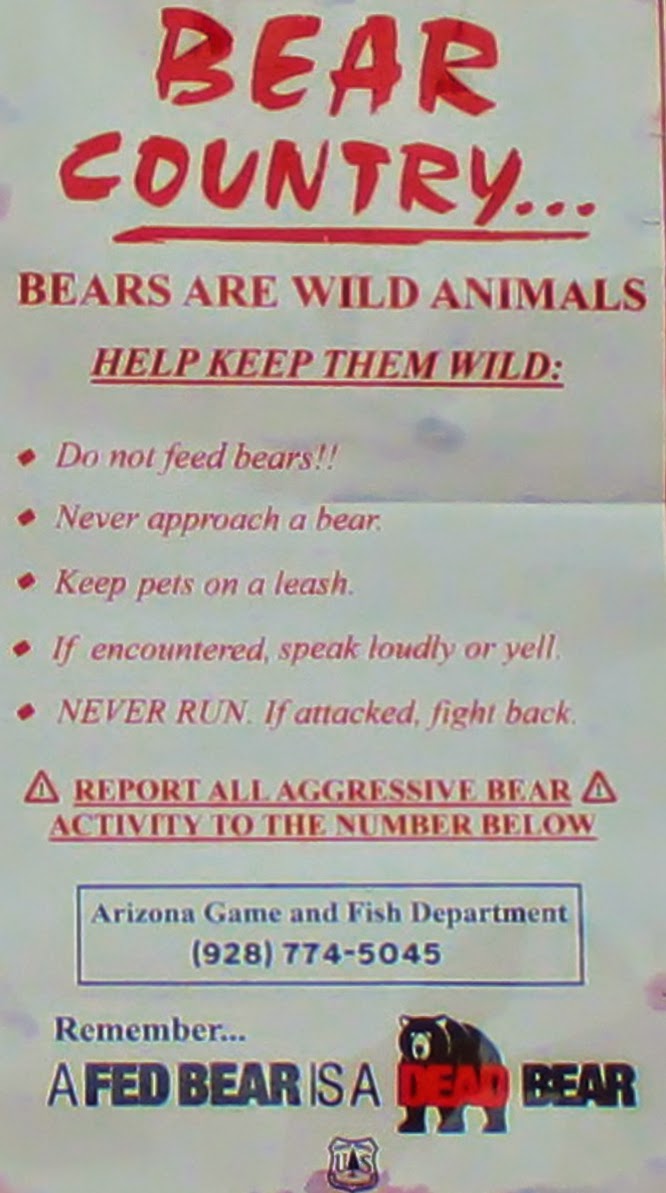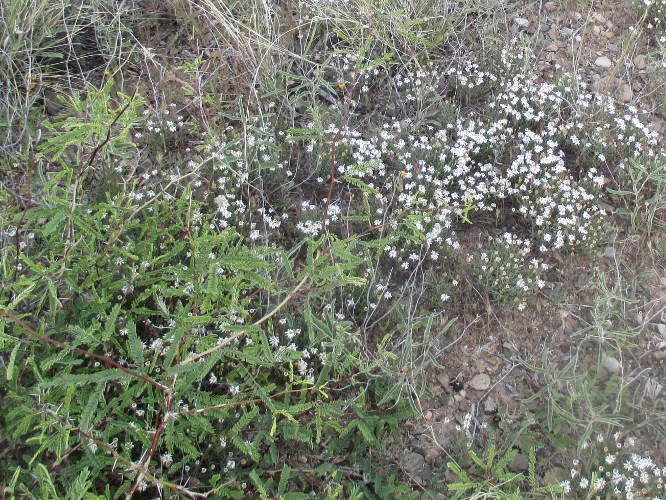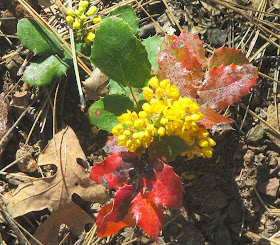The
weather forecast called for a 50% chance of rain when we met at 0700
on 25 April 2015 for our hike in Boynton Canyon. Generally cloudy
skies reinforced the forecast, but we decided to proceed anyway.
After all, this hike had been scheduled in part because we wanted to
prove to ourselves that we were ready for a campout and strenuous
hiking on the Mogollon Rim scheduled for the next weekend. If it
rained today we would just don our ponchos.
Leaving
the Safeway parking lot, we drove to Sedona, turned left onto Dry
Creek Road, drove 2.9 miles to the stop sign at the junction with
Boynton Pass and Long Canyon roads (Boyntons Pass Road to the left;
Long Canyon Road to the right), turned left onto Boynton Pass Road,
continued for 1.6 miles to a stop sign, turned right onto Boynton
Canyon Road and continued for about 0.1 mile before turning right
into the Boynton Canyon Trailhead parking lot.
We
donned our packs, posted our Red Rock Passes (actually in our case
Golden Age Passes), checked to make sure our ponchos were ready at
hand and headed up the trail.
 Displayed
prominently at the trailhead we found a sign (right)
reminding us that we were in bear country. However, the largest
animals we saw during our hike were a solitary rabbit, not too
bothered by our presence, and a single squirrel that scampered away
as soon as we approached. But we did notice several rocks that bears
had overturned in the search for grubs.
Displayed
prominently at the trailhead we found a sign (right)
reminding us that we were in bear country. However, the largest
animals we saw during our hike were a solitary rabbit, not too
bothered by our presence, and a single squirrel that scampered away
as soon as we approached. But we did notice several rocks that bears
had overturned in the search for grubs. Boynton Canyon Trail
and Deadmans Pass Trail share a common track for about 0.1 mile from
the parking lot before Deadmans Pass Trail turns to the right and
eventually joins Long Canyon Trail. We continued on Boynton Canyon
Trail, entering the Red Rock Secret Mountain Wilderness and passing a
small area virtually covered with primroses, such as the example
shown here (left).
Boynton Canyon Trail
and Deadmans Pass Trail share a common track for about 0.1 mile from
the parking lot before Deadmans Pass Trail turns to the right and
eventually joins Long Canyon Trail. We continued on Boynton Canyon
Trail, entering the Red Rock Secret Mountain Wilderness and passing a
small area virtually covered with primroses, such as the example
shown here (left).
Shortly
after the primroses, we came to a flower-covered hillside sporting a
variety of flowers The colorful flowers stood in stark contrast with
the dull red dirt of the otherwise bare hillside.
 |
Flowers on a bare red hillside
|
The
trail climbed sharply up the rocky north slope of the canyon, wending
its way through manzanita, scrub oak, juniper and other low-growing
plants, as it bypassed Enchantment Resort which sprawled, like a
cancer, across the mouth of the canyon.
 |
Enchantment Resort spreading across the mouth of Boynton Canyon
|
 The
rocky but well-maintained trail (right) continued its course along the
hillside above the resort for almost a mile before returning to the
canyon floor. The hiking was easy as we followed the gently sloping
trail up the canyon for the next mile to the point where our trail,
loosely called Boyntons Backyard, turns off Boynton Canyon Trail.
That does not mean that our trail left Boynton Canyon. On the
contrary, Boynton Canyon Trail leaves Boynton Canyon here, turning up
a box canyon and ending hard against Bear Mountain. Boynton Canyon,
meanwhile, continues essentially straight ahead to end at a steep
mountain saddle between Secret Mountain and Lost Mountain. What we
call Boyntons Backyard Trail which ends at that saddle is apparently
part of an old trail called Boynton-Hart Well Combo that continues
around the north side of Lost Mountain and leads down Hart Well
Canyon to Taylor Tank.
The
rocky but well-maintained trail (right) continued its course along the
hillside above the resort for almost a mile before returning to the
canyon floor. The hiking was easy as we followed the gently sloping
trail up the canyon for the next mile to the point where our trail,
loosely called Boyntons Backyard, turns off Boynton Canyon Trail.
That does not mean that our trail left Boynton Canyon. On the
contrary, Boynton Canyon Trail leaves Boynton Canyon here, turning up
a box canyon and ending hard against Bear Mountain. Boynton Canyon,
meanwhile, continues essentially straight ahead to end at a steep
mountain saddle between Secret Mountain and Lost Mountain. What we
call Boyntons Backyard Trail which ends at that saddle is apparently
part of an old trail called Boynton-Hart Well Combo that continues
around the north side of Lost Mountain and leads down Hart Well
Canyon to Taylor Tank.
The
turn off from Boyntons Canyon Trail is a bit obscure and I have had
to search for it both times I have hiked this trail. A couple of
dead limbs are placed across the turnoff to prevent hikers on
Boynton Canyon Trail from getting lost.
 |
Spot where we turned off to take Boyntons Backyard Trail
|
 At
first there is no discernible trail at the turnoff but it becomes
obvious after a few yards and continues along the left bank of the
wash for about 0.7 miles before dipping into the wash at a cairn and
following it upstream. The cairn (left)
was photographed while standing in the streambed. Except for two
major obstructions, described below, that had to be bypassed, hiking
in the wash was relatively easy. Footing was good with very few
loose rocks and we encountered no areas that required climbing.
At
first there is no discernible trail at the turnoff but it becomes
obvious after a few yards and continues along the left bank of the
wash for about 0.7 miles before dipping into the wash at a cairn and
following it upstream. The cairn (left)
was photographed while standing in the streambed. Except for two
major obstructions, described below, that had to be bypassed, hiking
in the wash was relatively easy. Footing was good with very few
loose rocks and we encountered no areas that required climbing.
As
for the two major obstructions, the first was about 0.2 miles
upstream from where we first entered the wash. Consisting of a
jumble of boulders and tree trunks blocking our way, it would have
been very difficult to climb over. However, just a few yards
downstream, we found a faint trail that allowed us to climb out of
the wash and bypass the area by hiking along the bank for about 100
yards.
 |
Obstruction in the Boynton Canyon wash
|
Back
in the wash we continued upstream for another 0.2 miles before
encountering another obstruction at a sharp bend in the wash and
bypassed it by traveling along an obvious if little used trail for
about 75 yards. Back in the wash, we continued for another 0.3 miles
before exiting again. Both previous exits had been to the right, were
quite short and occasioned by specific obstacles in the wash. This
time, on the other hand, we exited to the left bank and climbed along
a gently-sloping, fairly well-defined old trail for about 0.6 miles
before entering the wash for the fourth time. This time we basically
just crossed the wash and started a steep climb, at first close
against the face of a rock cliff, following a faint trail that leads
steeply up the mountain slope to end about 0.2 miles ahead at the
pass between Lost Mountain and Secret Mountain.
The
signals to my GPS played hop scotch between the canyon walls in the
upper reaches of Boynton Canyon, making any GPS track and any
resultant track drawn on a map useful only for general guidance.
That is the track points the hiker to the pass where the trail ends
but doesn't really show how to get there. That is true for a track I
downloaded from the internet as well as for the one I made myself on
a 25 February 2015 scouting hike. As we had done for that hike, we
just watched closely for the occasional cairn, evidence of long-ago
trimming and other signs of passage.
In
spite of those disclaimers, finding our way did not turn out to be
too difficult even if it was often tedious and time-consuming.
At
1230 we were still about 0.1 mile below the pass, but the weather was
looking more and more threatening and I already had a GPS track to
the top from my February hike, so we decided to eat lunch where we
were and head back.
Before
starting our return hike, I snapped a photograph of Lila admiring the
down-canyon view. In the center, above and just to the right of
Lila's head, is Thunder Mountain (shown on older maps as Capitol
Butte).
 |
Lila looking back down Boynton Canyon from just below the pass
|
Having
lingered to look at flowers on the way up the trail, we didn't bother
with them on the way down. We just hurried along trying to beat the
rain, a futile effort as it turned out. By the time we had crossed
the wash just below the extremely steep upper 0.2 miles of trail, I
was striking the bushes with my hiking pole to shake the water off
the leaves before passing. We were pretty well protected by our
ponchos anyway, but our lower legs did get very wet. Water ran into
my boots and my socks were thoroughly soaked when I got home.
Surprisingly, however, I was still quite comfortable. The bamboo
socks I was wearing did a great job of protecting my feet.
Although, as noted, we
didn't stop to sniff the flowers on the way back, we had admired our
share on the way up. George Everman was not with us on this hike,
but he later identified many of the flowers shown below for me.
Daisy Williams, who was along on the hike, was able to tell me the
names of others.
 We
easily found all of the places where we had entered and exited the
wash on the way up the trail and thus avoided any waiting time trying
to decide which way to go or time recovering from taking wrong turns.
We were also able to find the junction with Boynton Canyon Trail
(left) without any trouble. Note
that the blue track continuing to the left from the junction is
Boynton Canyon Trail as it leaves the main canyon and turns up a box
canyon. The red track is the route we followed. It is composed of
Boynton Canyon Trail below the junction and Boyntons Backyard Trail
the rest of the way up Boynton Canyon.
We
easily found all of the places where we had entered and exited the
wash on the way up the trail and thus avoided any waiting time trying
to decide which way to go or time recovering from taking wrong turns.
We were also able to find the junction with Boynton Canyon Trail
(left) without any trouble. Note
that the blue track continuing to the left from the junction is
Boynton Canyon Trail as it leaves the main canyon and turns up a box
canyon. The red track is the route we followed. It is composed of
Boynton Canyon Trail below the junction and Boyntons Backyard Trail
the rest of the way up Boynton Canyon.
We
paused, still in our ponchos, at the trail junction for a group
photograph.
 |
Left to right: Lila Wright, Joanne Hennings, Daisy Williams, Karl Sink (rear) and Jim Manning – author not shown
|
After
uploading my GPS track and removing a lot of noise (extraneous
cross-canyon hops), I measured the round trip hike as being 9.2
miles. The maximum elevation was 6065 feet and the total ascent was
2049 feet.
Our
track is shown in red on the included map (below). But beware, as already noted GPS signals are
highly inaccurate in the narrower parts of the canyon. A location
may be shown on one side of the canyon when it is actually on the
other. The blue track on the map shows Boynton Canyon Trail as it
leaves Boynton Canyon and continues up a box canyon.











































